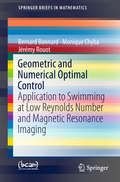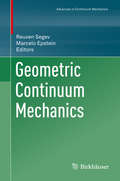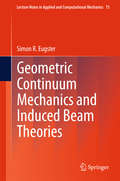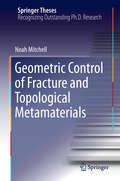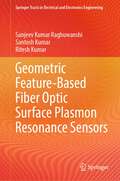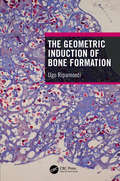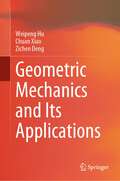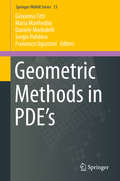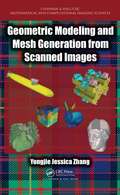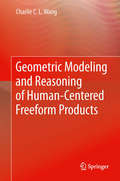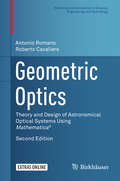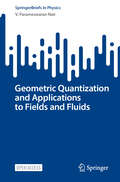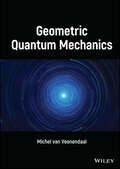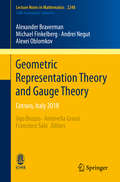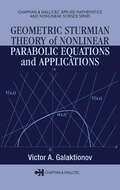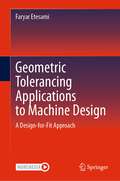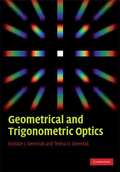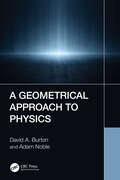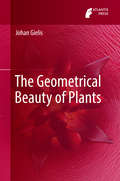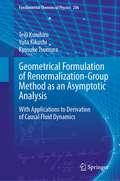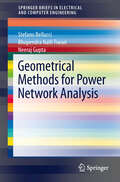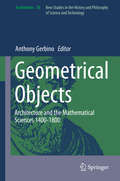- Table View
- List View
Geometric and Numerical Optimal Control: Application to Swimming at Low Reynolds Number and Magnetic Resonance Imaging (SpringerBriefs in Mathematics)
by Bernard Bonnard Monique Chyba Jérémy RouotThis book introduces readers to techniques of geometric optimal control as well as the exposure and applicability of adapted numerical schemes. It is based on two real-world applications, which have been the subject of two current academic research programs and motivated by industrial use – the design of micro-swimmers and the contrast problem in medical resonance imaging. The recently developed numerical software has been applied to the cases studies presented here. The book is intended for use at the graduate and Ph.D. level to introduce students from applied mathematics and control engineering to geometric and computational techniques in optimal control.
Geometric and Topological Methods for Quantum Field Theory
by Alexander Cardona Iván Contreras Andrés F. Reyes-LegaThis volume offers an introduction, in the form of four extensive lectures, to some recent developments in several active topics at the interface between geometry, topology and quantum field theory. The first lecture is by Christine Lescop on knot invariants and configuration spaces, in which a universal finite-type invariant for knots is constructed as a series of integrals over configuration spaces. This is followed by the contribution of Raimar Wulkenhaar on Euclidean quantum field theory from a statistical point of view. The author also discusses possible renormalization techniques on noncommutative spaces. The third lecture is by Anamaria Font and Stefan Theisen on string compactification with unbroken supersymmetry. The authors show that this requirement leads to internal spaces of special holonomy and describe Calabi-Yau manifolds in detail. The last lecture, by Thierry Fack, is devoted to a K-theory proof of the Atiyah-Singer index theorem and discusses some applications of K-theory to noncommutative geometry. These lectures notes, which are aimed in particular at graduate students in physics and mathematics, start with introductory material before presenting more advanced results. Each chapter is self-contained and can be read independently.
Geometric Continuum Mechanics (Advances in Mechanics and Mathematics #42)
by Marcelo Epstein Reuven SegevThis contributed volume explores the applications of various topics in modern differential geometry to the foundations of continuum mechanics. In particular, the contributors use notions from areas such as global analysis, algebraic topology, and geometric measure theory. Chapter authors are experts in their respective areas, and provide important insights from the most recent research. Organized into two parts, the book first covers kinematics, forces, and stress theory, and then addresses defects, uniformity, and homogeneity. Specific topics covered include:Global stress and hyper-stress theoriesApplications of de Rham currents to singular dislocationsManifolds of mappings for continuum mechanicsKinematics of defects in solid crystalsGeometric Continuum Mechanics will appeal to graduate students and researchers in the fields of mechanics, physics, and engineering who seek a more rigorous mathematical understanding of the area. Mathematicians interested in applications of analysis and geometry will also find the topics covered here of interest.
Geometric Continuum Mechanics and Induced Beam Theories
by Simon R. EugsterThis research monograph discusses novel approaches to geometric continuum mechanics and introduces beams as constraint continuous bodies. In the coordinate free and metric independent geometric formulation of continuum mechanics as well as for beam theories, the principle of virtual work serves as the fundamental principle of mechanics. Based on the perception of analytical mechanics that forces of a mechanical system are defined as dual quantities to the kinematical description, the virtual work approach is a systematic way to treat arbitrary mechanical systems. Whereas this methodology is very convenient to formulate induced beam theories, it is essential in geometric continuum mechanics when the assumptions on the physical space are relaxed and the space is modeled as a smooth manifold. The book addresses researcher and graduate students in engineering and mathematics interested in recent developments of a geometric formulation of continuum mechanics and a hierarchical development of induced beam theories.
Geometric Control of Fracture and Topological Metamaterials (Springer Theses)
by Noah MitchellThis thesis reports a rare combination of experiment and theory on the role of geometry in materials science. It is built on two significant findings: that curvature can be used to guide crack paths in a predictive way, and that protected topological order can exist in amorphous materials. In each, the underlying geometry controls the elastic behavior of quasi-2D materials, enabling the control of crack propagation in elastic sheets and the control of unidirectional waves traveling at the boundary of metamaterials. The thesis examines the consequences of this geometric control in a range of materials spanning many orders of magnitude in length scale, from amorphous macroscopic networks and elastic continua to nanoscale lattices.
Geometric Feature-Based Fiber Optic Surface Plasmon Resonance Sensors (Springer Tracts in Electrical and Electronics Engineering)
by Sanjeev Kumar Raghuwanshi Santosh Kumar Ritesh KumarThis book focuses on the surface plasmon resonance (SPR) technique covering fibre optic sensor research. It highlights recent advancements in geometric feature-based fibre optic SPR sensors for chemical/biochemical/biosensor applications. The contents also discuss the principle of the SPR sensing technique as well as various designs of fibre optic SPR probes for improving sensor sensitivity. It also includes numerous examples of SPR-based fibre optic sensors with various geometric (such as U-type, taper type, D-type, and interferometric-based) sensors. This volume will be a useful reference to those in academia and industry especially researchers with useful information focusing on fibre optic SPR sensors.
The Geometric Induction of Bone Formation
by Ugo RipamontiThe Geometric Induction of Bone Formation describes new biomimetic biomaterials that offer mechanistic osteogenic surfaces for the autonomous and spontaneous induction of bone formation without the addition of osteogenic soluble molecular signals of the transforming growth factor-β supergene family. The chapters frame our understanding of regenerative medicine in primate species, including humans. The goal is to unravel the fundamental biological mechanisms of bone formation unique to non-human and human primates. The broad target audience dovetails with several disciplines both in the academic and private biotech sectors primarily involved in molecular biology, tissue biology, tissue engineering, biomaterial science, and reconstructive, orthopaedic, plastic, and dental surgery. Key Features Includes outstanding images of undecalcified whole mounted sections Summarizes non-human primate research – ideal for clinical translation Reviews methods for creating devices capable of making bone autonomously, i.e. an intrinsically osteo-inductive bioreactor and/or biomaterial Describes the spontaneous induction of bone formation including a whole spectrum of tissue biology, from basic molecular biology to clear-cut morphology and pre-clinical application in non-human primate species Intended for audiences in both academic research and the biotech industry
Geometric Mechanics and Its Applications
by Weipeng Hu Chuan Xiao Zichen DengTo make the content of the book more systematic, this book mainly briefs some related basic knowledge reported by other monographs and papers about geometric mechanics. The main content of this book is based on the last 20 years’ jobs of the authors. All physical processes can be formulated as the Hamiltonian form with the energy conservation law as well as the symplectic structure if all dissipative effects are ignored. On the one hand, the important status of the Hamiltonian mechanics is emphasized. On the other hand, a higher requirement is proposed for the numerical analysis on the Hamiltonian system, namely the results of the numerical analysis on the Hamiltonian system should reproduce the geometric properties of which, including the first integral, the symplectic structure as well as the energy conservation law.
Geometric Methods in PDE's
by Giovanna Citti Maria Manfredini Daniele Morbidelli Sergio Polidoro Francesco UguzzoniThe analysis of PDEs is a prominent discipline in mathematics research, both in terms of its theoretical aspects and its relevance in applications. In recent years, the geometric properties of linear and nonlinear second order PDEs of elliptic and parabolic type have been extensively studied by many outstanding researchers. This book collects contributions from a selected group of leading experts who took part in the INdAM meeting "Geometric methods in PDEs", on the occasion of the 70th birthday of Ermanno Lanconelli. They describe a number of new achievements and/or the state of the art in their discipline of research, providing readers an overview of recent progress and future research trends in PDEs. In particular, the volume collects significant results for sub-elliptic equations, potential theory and diffusion equations, with an emphasis on comparing different methodologies and on their implications for theory and applications.
Geometric Modeling and Mesh Generation from Scanned Images (Chapman & Hall/CRC Mathematical and Computational Imaging Sciences Series #6)
by Yongjie Jessica ZhangCutting-Edge Techniques to Better Analyze and Predict Complex Physical Phenomena Geometric Modeling and Mesh Generation from Scanned Images shows how to integrate image processing, geometric modeling, and mesh generation with the finite element method (FEM) to solve problems in computational biology, medicine, materials science, and engineering. Based on the author’s recent research and course at Carnegie Mellon University, the text explains the fundamentals of medical imaging, image processing, computational geometry, mesh generation, visualization, and finite element analysis. It also explores novel and advanced applications in computational biology, medicine, materials science, and other engineering areas. One of the first to cover this emerging interdisciplinary field, the book addresses biomedical/material imaging, image processing, geometric modeling and visualization, FEM, and biomedical and engineering applications. It introduces image-mesh-simulation pipelines, reviews numerical methods used in various modules of the pipelines, and discusses several scanning techniques, including ones to probe polycrystalline materials. The book next presents the fundamentals of geometric modeling and computer graphics, geometric objects and transformations, and curves and surfaces as well as two isocontouring methods: marching cubes and dual contouring. It then describes various triangular/tetrahedral and quadrilateral/hexahedral mesh generation techniques. The book also discusses volumetric T-spline modeling for isogeometric analysis (IGA) and introduces some new developments of FEM in recent years with applications.
Geometric Modeling and Reasoning of Human-Centered Freeform Products
by Charlie C. WangThe recent trend in user-customized product design requires the shape of products to be automatically adjusted according to the human body's shape, so that people will feel more comfortable when wearing these products. Geometric approaches can be used to design the freeform shape of products worn by people, which can greatly improve the efficiency of design processes in various industries involving customized products (e.g., garment design, toy design, jewel design, shoe design, and design of medical devices, etc.). These products are usually composed of very complex geometric shapes (represented by free-form surfaces), and are not driven by a parameter table but a digital human model with free-form shapes or part of human bodies (e.g., wrist, foot, and head models). Geometric Modeling and Reasoning of Human-Centered Freeform Products introduces the algorithms of human body reconstruction, freeform product modeling, constraining and reconstructing freeform products, and shape optimization for improving the manufacturability of freeform products. Based on these techniques, the design automation problem for human-centered freeform products can be fundamentally solved. Researchers and developers working on problems of automatic designing individually customized products can use this book as a reference, and it can also be used in courses in computer-aided product design at the graduate level.
Geometric Optics
by Antonio Romano Roberto CavaliereThis book--unique in the literature--provides readers with the mathematical background needed to design many of the optical combinations that are used in astronomical telescopes and cameras. The results presented in the work were obtained by using a different approach to third-order aberration theory as well as the extensive use of the software package Mathematica®. Replete with workout examples and exercises, Geometric Optics is an excellent reference for advanced graduate students, researchers, and practitioners in applied mathematics, engineering, astronomy, and astronomical optics. The work may be used as a supplementary textbook for graduate-level courses in astronomical optics, optical design, optical engineering, programming with Mathematica, or geometric optics.
Geometric Quantization and Applications to Fields and Fluids (SpringerBriefs in Physics)
by V. Parameswaran NairThis open access book explains geometric quantization from a physicist’s perspective. After presenting the general formalism, it delves into several examples reflecting current research interests in high-energy physics and condensed matter physics. Applications explore Chern-Simons theory, theta vacuum, the Hall effect, fluid dynamics, and elements of noncommutative geometry. The content is tailored to appeal to researchers, graduate students, and advanced undergraduates in high-energy physics, particle physics, and mathematical physics. A background in differential geometry and group theory is beneficial for a comprehensive understanding of the discussions.
Geometric Quantum Mechanics
by Michel van VeenendaalGeometric Quantum Mechanics Unique senior undergraduate/graduate level textbook on quantum mechanics that employs an intuitive, geometry-driven approach to the subject Geometric Quantum Mechanics is a textbook for quantum mechanics at the senior undergraduate and graduate level and follows a unique approach to the material. The first chapter starts with the discussion of the properties of space leading to an understanding of operator techniques, Pauli matrices, spinors, quantum angular momentum, etc. Techniques from geometric algebra is frequently employed leading to more intuitive insights into the concepts. The second chapter extends the results to spacetime. The study of the motion in and the production of electromagnetic fields leads to the Lorentz and Maxwell equations, respectively. The nonrelativistic limit leads to the Schrödinger/Heisenberg equations. This provides an overview how different fields are linked to each other. The following chapters discuss applications of quantum mechanics. This covers a very broad area of physics showing how the ideas from quantum mechanics affect different fields. These are subdivided into chapters on single-particle problems, many-particle systems, and collective and emergent phenomena. The coverage includes the fundamental forces, atoms, molecules and solids, nuclear and particle physics, mass generation and the Higgs field, superconductivity, superfluidity, etc. The book restricts itself to the essence of these topics allowing the reader to understand how quantum mechanics impacts modern-day physics and chemistry. It appeals to instructors and students due to its different approach with its extensive use of geometric algebra and the broad range of modern applications.
Geometric Representation Theory and Gauge Theory: Cetraro, Italy 2018 (Lecture Notes in Mathematics #2248)
by Alexander Braverman Michael Finkelberg Andrei Negut Alexei OblomkovThis book offers a review of the vibrant areas of geometric representation theory and gauge theory, which are characterized by a merging of traditional techniques in representation theory with the use of powerful tools from algebraic geometry, and with strong inputs from physics. The notes are based on lectures delivered at the CIME school "Geometric Representation Theory and Gauge Theory" held in Cetraro, Italy, in June 2018. They comprise three contributions, due to Alexander Braverman and Michael Finkelberg, Andrei Negut, and Alexei Oblomkov, respectively. Braverman and Finkelberg’s notes review the mathematical theory of the Coulomb branch of 3D N=4 quantum gauge theories. The purpose of Negut’s notes is to study moduli spaces of sheaves on a surface, as well as Hecke correspondences between them. Oblomkov's notes concern matrix factorizations and knot homology. This book will appeal to both mathematicians and theoretical physicists and will be a source of inspiration for PhD students and researchers.
Geometric Structure of Chemistry-Relevant Graphs
by Michel-Marie Deza Mathieu Dutour Sikirić Mikhail Ivanovitch ShtogrinThe central theme of the present book is zigzags and central-circuits of three- or four-regular plane graphs, which allow a double covering or covering of the edgeset to be obtained. The book presents zigzag and central circuit structures of geometric fullerenes and several other classes of graph of interest in the fields of chemistry and mathematics. It also discusses the symmetries, parameterization and the Goldberg-Coxeter construction for those graphs. It is the first book on this subject, presenting full structure theory of such graphs. While many previous publications only addressed particular questions about selected graphs, this book is based on numerous computations and presents extensive data (tables and figures), as well as algorithmic and computational information. It will be of interest to researchers and students of discrete geometry, mathematical chemistry and combinatorics, as well as to lay mathematicians.
Geometric Sturmian Theory of Nonlinear Parabolic Equations and Applications (Chapman & Hall/CRC Applied Mathematics & Nonlinear Science)
by Victor A. GalaktionovUnlike the classical Sturm theorems on the zeros of solutions of second-order ODEs, Sturm's evolution zero set analysis for parabolic PDEs did not attract much attention in the 19th century, and, in fact, it was lost or forgotten for almost a century. Briefly revived by P�lya in the 1930's and rediscovered in part several times since, it was not un
Geometric Tolerancing Standard to Machine Design: A Design-for-Fit Approach
by Faryar EtesamiThis book is for students enrolled in undergraduate mechanical engineering, or similar, programs. The material presented is based on nearly thirty years of class-tested lecture notes for courses on the applications of geometric tolerancing for designers. The book’s emphasis is on fit requirements for machine components, as fit assurance makes up the majority of challenging applications in tolerancing. For design engineers, knowing how to apply geometric tolerances has been a challenge even for engineers who have practiced geometric tolerancing for a long time. The syntax and meaning of geometric tolerancing statements can be learned easily and quickly, but knowing how to use them correctly is much more difficult. In the Design-for-Fit approach, the presentation starts with the geometric requirements for various kinds of fit and then presents the geometric tolerance statements necessary to achieve those fits.
Geometrical and Trigonometric Optics
by Eustace Dereniak Teresa D. DereniakThis new and up-to-date book covers the modern geometrical aspects of optics, which is the fundamental level of understanding the technology. Beginning with how light is generated and how fast it travels, the book discusses how materials interact with light, how various materials affect the velocity of light, and the ramifications of change in the speed of light. The concept of the index of refraction, and how it is used with Snell's law to produce image forming systems, is developed. An ideal textbook for advanced undergraduate level courses in geometrical optics, this book will also interest those wanting to learn the concepts and theory of geometrical optics. Each chapter contains worked examples, and there are exercises to reinforce the reader's understanding of material.
A Geometrical Approach to Physics
by David A. Burton Adam NobleThis book provides an accessible introduction to using the tools of differential geometry to tackle a wide range of topics in physics, with the concepts developed through numerous examples to help the reader become familiar with the techniques.Physical applications are used to develop the techniques and demonstrate their wide-ranging applicability. Formalism is introduced sparingly and step-by-step, where it is needed, and chapters contain exercises for readers to test their understanding. Worked solutions to the exercises are included.It is an ideal textbook for advanced undergraduate or postgraduate courses on mathematical methods for physicists, for students whose background is in physics rather than mathematics. It is assumed that the reader has no prior knowledge of mathematical methods beyond the content of a standard undergraduate physics degree.The purpose of the book is to act as a ‘gateway’ to more advanced books on the applications of differential geometry in physics. It will also help the reader to better appreciate modern physics research that makes use of differential geometry, and the common features that permeate the discipline as a whole.Key Features: Presents a light and accessible treatment. Can be used as a textbook for a short course on mathematical methods for physicists. Accessible to advanced undergraduates and postgraduates whose background is in physics, not mathematics. David A. Burton received his PhD from Lancaster University, UK, in 2000 and was appointed Lecturer in Physics there in 2005. He is currently Senior Lecturer in Physics at Lancaster. He began his research career in relativistic continuum mechanics and gravitational physics before turning to fluid-structure interactions (in particular, vortex-induced vibration) and, in later years, to relativistic laser-plasma interactions.Adam Noble received his PhD in 2006, also from Lancaster University, and has since held postdoctoral positions at Lancaster and the University of Strathclyde, Scotland, where he is currently a Research Fellow. His interests lie at the interface of physics with geometry, in particular electrodynamics of intense fields, plasma physics and particle physics.The authors maintain a long-standing collaboration and, over the years, have worked on a number of topics connecting electromagnetics, gravitation and plasma physics, including gravitational Sagnac interferometry, relativistic wave-breaking in plasmas, radiation reaction in relativistic plasmas and charged particle beams, and the use of laser-wakefield accelerators in searches for light, weakly-interacting, candidates for dark matter.
The Geometrical Beauty of Plants
by Johan GielisThis book focuses on the origin of the Gielis curves, surfaces and transformations in the plant sciences. It is shown how these transformations, as a generalization of the Pythagorean Theorem, play an essential role in plant morphology and development. New insights show how plants can be understood as developing mathematical equations, which opens the possibility of directly solving analytically any boundary value problems (stress, diffusion, vibration. . . ) . The book illustrates how form, development and evolution of plants unveil as a musical symphony. The reader will gain insight in how the methods are applicable in many divers scientific and technological fields.
Geometrical Charged-Particle Optics
by Harald RoseThis second edition is an extended version of the first edition of Geometrical Charged-Particle Optics. The updated reference monograph is intended as a guide for researchers and graduate students who are seeking a comprehensive treatment of the design of instruments and beam-guiding systems of charged particles and their propagation in electromagnetic fields. Wave aspects are included in this edition for explaining electron holography, the Aharanov-Bohm effect and the resolution of electron microscopes limited by diffraction. Several methods for calculating the electromagnetic field are presented and procedures are outlined for calculating the properties of systems with arbitrarily curved axis. Detailed methods are presented for designing and optimizing special components such as aberration correctors, spectrometers, energy filters monochromators, ion traps, electron mirrors and cathode lenses. In particular, the optics of rotationally symmetric lenses, quadrupoles, and systems composed of these elements are discussed extensively. Beam properties such as emittance, brightness, transmissivity and the formation of caustics are outlined. Relativistic motion and spin precession of the electron are treated in a covariant way by introducing the Lorentz-invariant universal time and by extending Hamilton's principle from three to four spatial dimensions where the laboratory time is considered as the fourth pseudo-spatial coordinate. Using this procedure and introducing the self action of the electron, its accompanying electromagnetic field and its radiation field are calculated for arbitrary motion. In addition, the Stern-Gerlach effect is revisited for atomic and free electrons.
Geometrical Formulation of Renormalization-Group Method as an Asymptotic Analysis: With Applications to Derivation of Causal Fluid Dynamics (Fundamental Theories of Physics #206)
by Teiji Kunihiro Yuta Kikuchi Kyosuke TsumuraThis book presents a comprehensive account of the renormalization-group (RG) method and its extension, the doublet scheme, in a geometrical point of view. It extract long timescale macroscopic/mesoscopic dynamics from microscopic equations in an intuitively understandable way rather than in a mathematically rigorous manner and introduces readers to a mathematically elementary, but useful and widely applicable technique for analyzing asymptotic solutions in mathematical models of nature. The book begins with the basic notion of the RG theory, including its connection with the separation of scales. Then it formulates the RG method as a construction method of envelopes of the naive perturbative solutions containing secular terms, and then demonstrates the formulation in various types of evolution equations. Lastly, it describes successful physical examples, such as stochastic and transport phenomena including second-order relativistic as well as nonrelativistic fluid dynamics with causality and transport phenomena in cold atoms, with extensive numerical expositions of transport coefficients and relaxation times. Requiring only an undergraduate-level understanding of physics and mathematics, the book clearly describes the notions and mathematical techniques with a wealth of examples. It is a unique and can be enlightening resource for readers who feel mystified by renormalization theory in quantum field theory.
Geometrical Methods for Power Network Analysis
by Neeraj Gupta Bhupendra Nath Tiwari Stefano BellucciThis book is a short introduction to power system planning and operation using advanced geometrical methods. The approach is based on well-known insights and techniques developed in theoretical physics in the context of Riemannian manifolds. The proof of principle and robustness of this approach is examined in the context of the IEEE 5 bus system. This work addresses applied mathematicians, theoretical physicists and power engineers interested in novel mathematical approaches to power network theory.
Geometrical Objects
by Anthony GerbinoThis volume explores the mathematical character of architectural practice in diverse pre- and early modern contexts It takes an explicitly interdisciplinary approach, which unites scholarship in early modern architecture with recent work in the history of science, in particular, on the role of practice in the "scientific revolution" As a contribution to architectural history, the volume contextualizes design and construction in terms of contemporary mathematical knowledge, attendant forms of mathematical practice, and relevant social distinctions between the mathematical professions As a contribution to the history of science, the volume presents a series of micro-historical studies that highlight issues of process, materiality, and knowledge production in specific, situated, practical contexts Our approach sees the designer's studio, the stone-yard, the drawing floor, and construction site not merely as places where the architectural object takes shape, but where mathematical knowledge itself is deployed, exchanged, and amplified among various participants in the building process.
